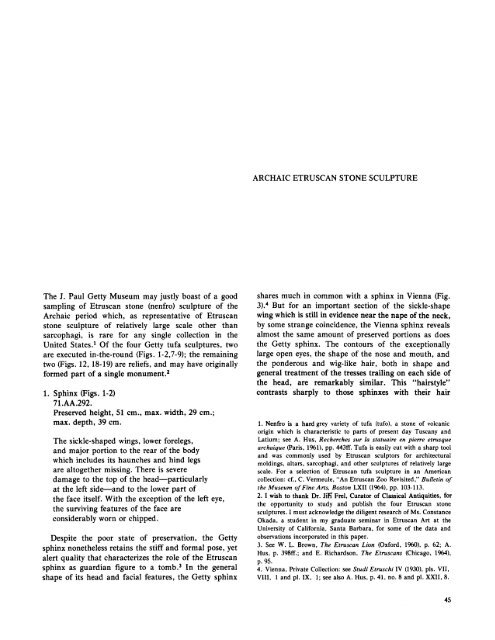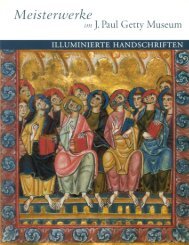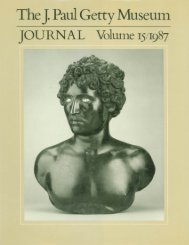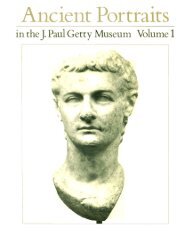The J. Paul Getty Museum Journal Volume 5 1977
The J. Paul Getty Museum Journal Volume 5 1977
The J. Paul Getty Museum Journal Volume 5 1977
Create successful ePaper yourself
Turn your PDF publications into a flip-book with our unique Google optimized e-Paper software.
ARCHAIC ETRUSCAN STONE SCULPTURE<br />
<strong>The</strong> J. <strong>Paul</strong> <strong>Getty</strong> <strong>Museum</strong> may justly boast of a good<br />
sampling of Etruscan stone (nenfro) sculpture of the<br />
Archaic period which, as representative of Etruscan<br />
stone sculpture of relatively large scale other than<br />
sarcophagi, is rare for any single collection in the<br />
United States. 1 Of the four <strong>Getty</strong> tufa sculptures, two<br />
are executed in-the-round (Figs. 1-2,7-9); the remaining<br />
two (Figs. 12, 18-19) are reliefs, and may have originally<br />
formed part of a single monument. 2<br />
1. Sphinx (Figs. 1-2)<br />
71.AA.292.<br />
Preserved height, 51 cm., max. width, 29 cm.;<br />
max. depth, 39 cm.<br />
<strong>The</strong> sickle-shaped wings, lower forelegs,<br />
and major portion to the rear of the body<br />
which includes its haunches and hind legs<br />
are altogether missing. <strong>The</strong>re is severe<br />
damage to the top of the head—particularly<br />
at the left side—and to the lower part of<br />
the face itself. With the exception of the left eye,<br />
the surviving features of the face are<br />
considerably worn or chipped.<br />
Despite the poor state of preservation, the <strong>Getty</strong><br />
sphinx nonetheless retains the stiff and formal pose, yet<br />
alert quality that characterizes the role of the Etruscan<br />
sphinx as guardian figure to a tomb. 3 In the general<br />
shape of its head and facial features, the <strong>Getty</strong> sphinx<br />
shares much in common with a sphinx in Vienna (Fig.<br />
3). 4 But for an important section of the sickle-shape<br />
wing which is still in evidence near the nape of the neck,<br />
by some strange coincidence, the Vienna sphinx reveals<br />
almost the same amount of preserved portions as does<br />
the <strong>Getty</strong> sphinx. <strong>The</strong> contours of the exceptionally<br />
large open eyes, the shape of the nose and mouth, and<br />
the ponderous and wig-like hair, both in shape and<br />
general treatment of the tresses trailing on each side of<br />
the head, are remarkably similar. This "hairstyle"<br />
contrasts sharply to those sphinxes with their hair<br />
1. Nenfro is a hard grey variety of tufa (tufo), a stone of volcanic<br />
origin which is characteristic to parts of present day Tuscany and<br />
Latium; see A. Hus, Recherches sur la statuaire en pierre étrusque<br />
archaïque (Paris, 1961), pp. 443ff. Tufa is easily cut with a sharp tool<br />
and was commonly used by Etruscan sculptors for architectural<br />
moldings, altars, sarcophagi, and other sculptures of relatively large<br />
scale. For a selection of Etruscan tufa sculpture in an American<br />
collection: cf., C. Vermeule, "An Etruscan Zoo Revisited," Bulletin of<br />
the <strong>Museum</strong> of Fine Arts, Boston LXII (1964), pp. 103-113.<br />
2. I wish to thank Dr. Jifí Freí, Curator of Classical Antiquities, for<br />
the opportunity to study and publish the four Etruscan stone<br />
sculptures. I must acknowledge the diligent research of Ms. Constance<br />
Okada, a student in my graduate seminar in Etruscan Art at the<br />
University of California, Santa Barbara, for some of the data and<br />
observations incorporated in this paper.<br />
3. See W. L. Brown, <strong>The</strong> Etruscan Lion (Oxford, 1960), p. 62; A.<br />
Hus, p. 398ff.; and E. Richardson, <strong>The</strong> Etruscans (Chicago, 1964),<br />
p. 95.<br />
4. Vienna, Private Collection: see Studi Etruschi IV (1930), pis. VII,<br />
VIII, 1 and pi. IX, 1; see also A. Hus, p. 41, no. 8 and pi. XXII, 8.<br />
45








